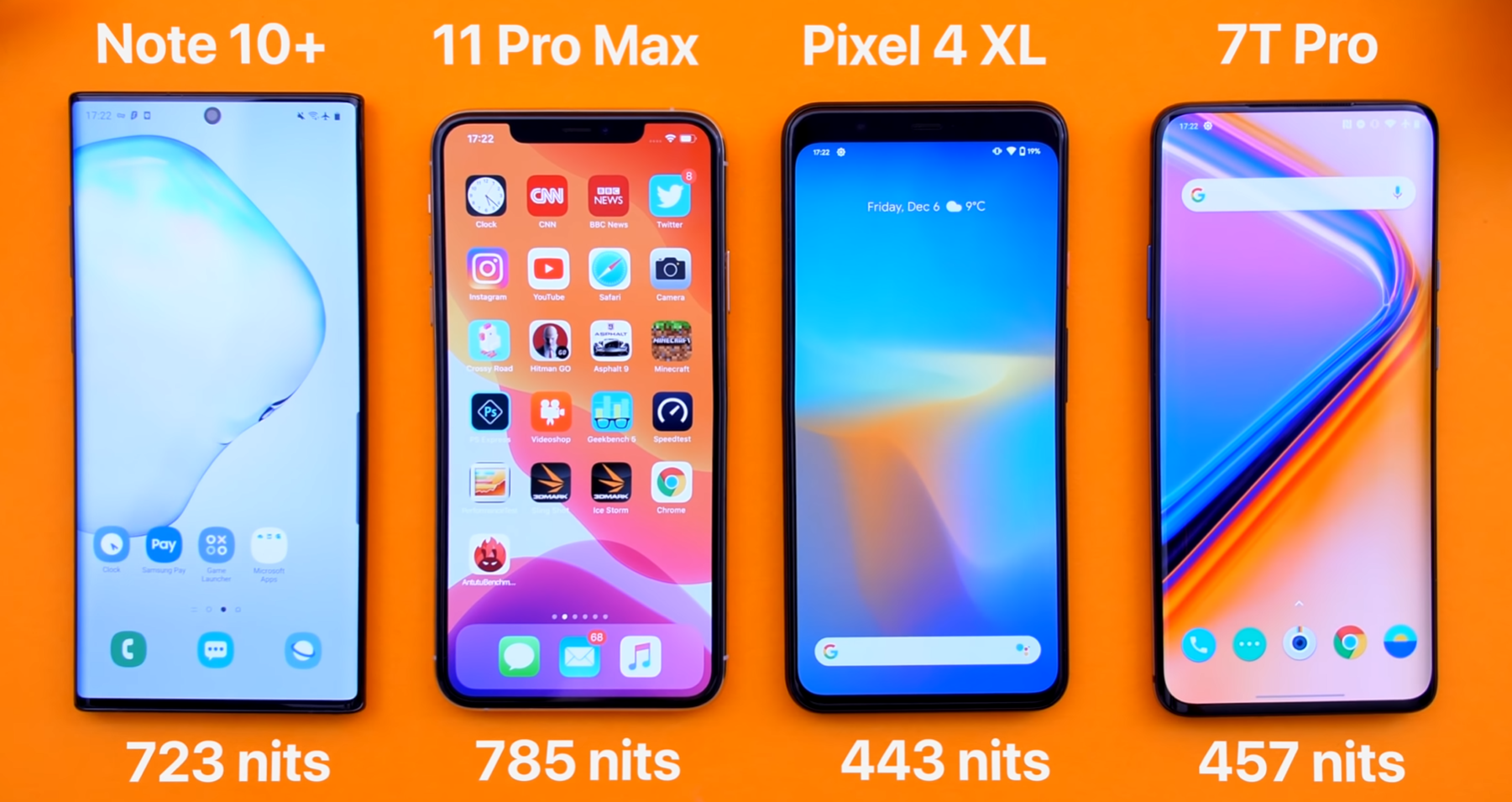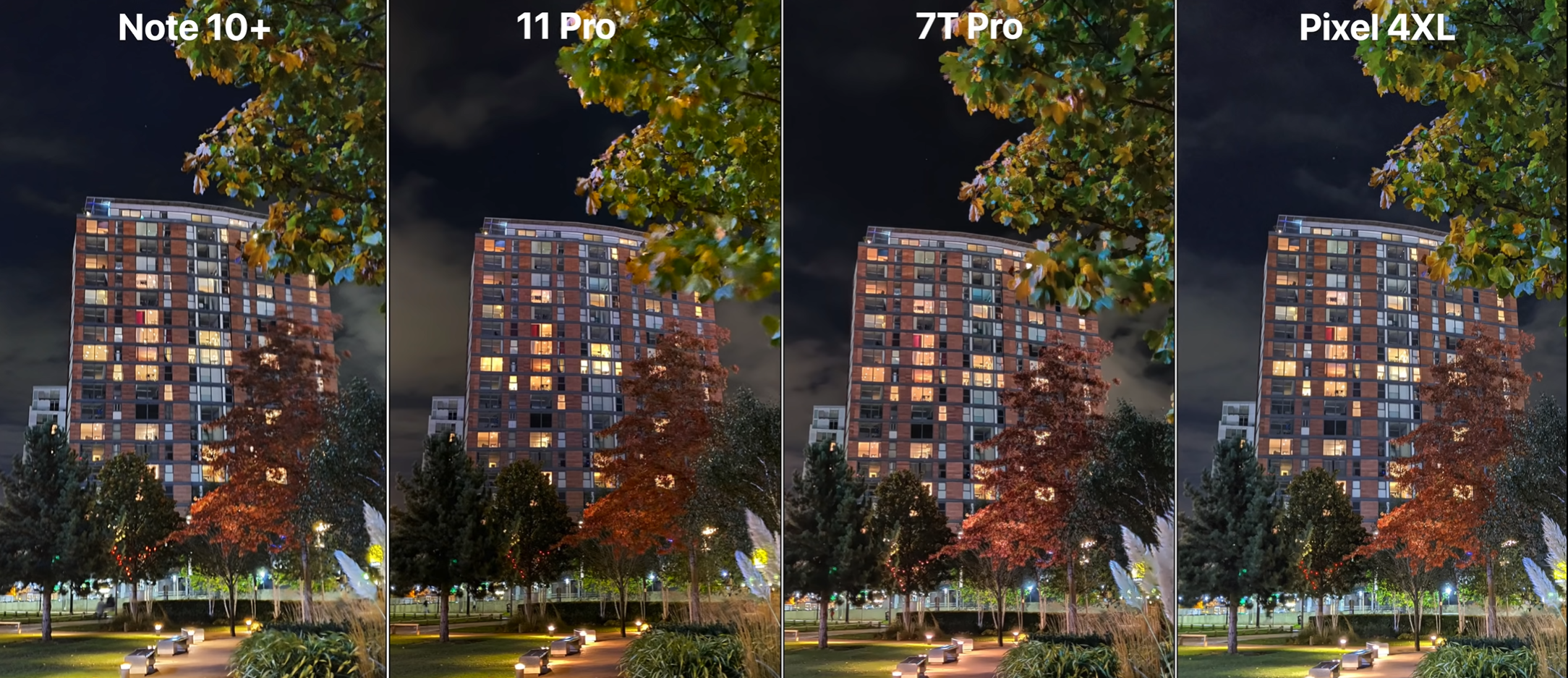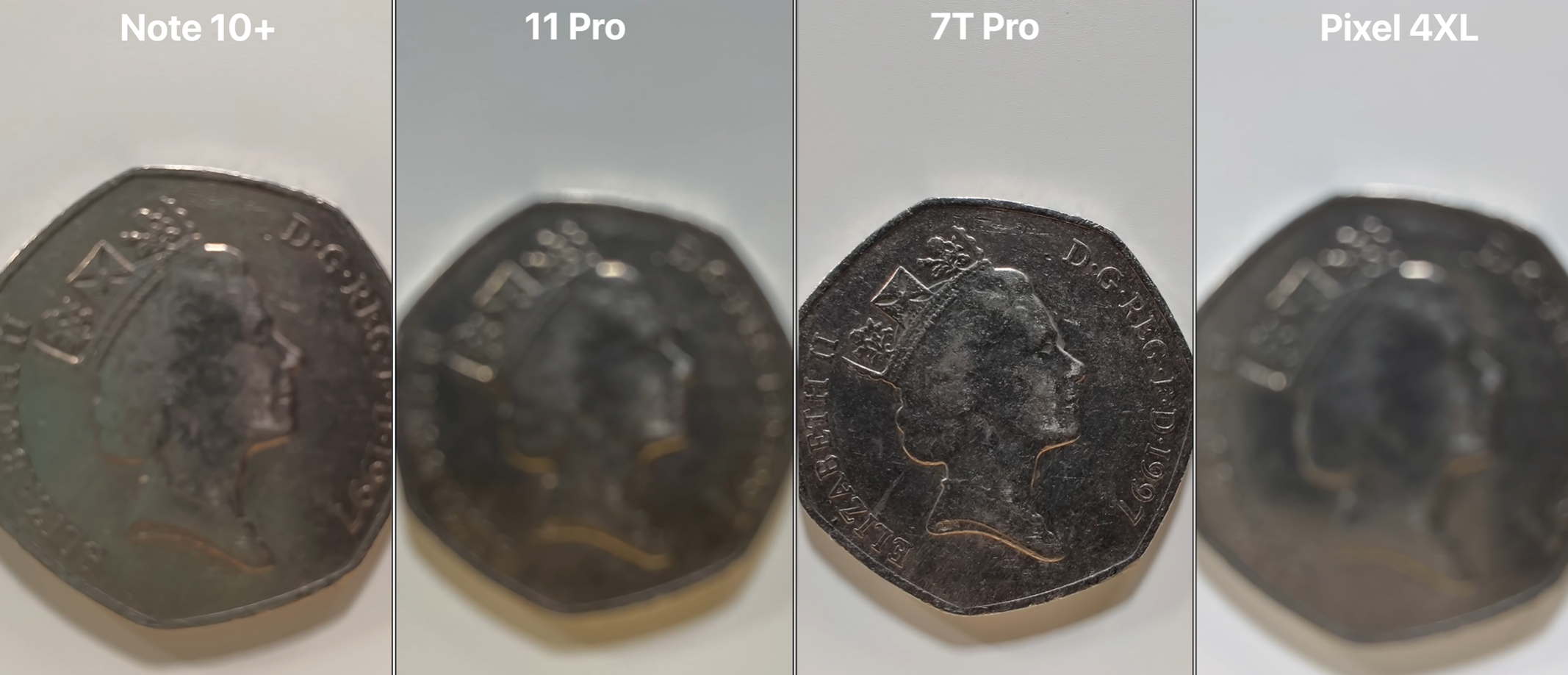This is the OnePlus 7T Pro. It’s definitely not the best name in a smartphone, but hey I’ve seen worst. Before I get into this I do want to say that the Samsung Galaxy Note 10+ is the best Android phone of 2019 in terms of the amount of features that you get, there’s absolutely no denying that. We did a full review video after over two months of use. So feel free to check that out here.
But the OnePlus 7T Pro is the best Android Phone of 2019 in terms of value. You get pretty much everything you could ask for in a phone, at a much much lower price than the Galaxy Note 10+.
So without any further adieu, here is my full review covering my final thoughts on the OnePlus 7T Pro!
DESIGN
Ok, so most of you reading this are probably familiar with OnePlus as a company and what their vision stands for. In case you’re not, they’re basically trying to make flagship smartphones at affordable prices.
A design comparison between the OnePlus 7T Pro (Top) and the OnePlus 7 Pro (Bottom)
Now they do have to cut some corners in order to achieve that, which I’ll talk about in this review. To give you one example the OnePlus 7T Pro pretty much takes the crown when it comes to the least amount of changes from the previous generation ever. The OnePlus 7T Pro which came out in October is almost an identical copy of the OnePlus 7 Pro that we got back in May.
But it is still an incredible phone, and that’s because the 7T Pro is still one of the only phones in 2019 that does not have a notch or even a camera cutout at all. We get is a full screen display with zero interruptions for you to watch your content, which is just incredible!
Now, the screen-bezels, or should I say the frame of the phone, is indeed thicker than on other phones such as the iPhone 11 Pro Max or the Samsung Galaxy Note 10+, but considering that you don’t get any cutouts in the display itself, I’m very happy with this tiny trade-off. The 7T Pro simply looks like a phone that came from the future, 2020 or even 2021, where smartphones are just a full-screen display. It looks incredible and I’m absolutely in love with the design of this phone!
The back is made out of glass, but it does have this frosted glass texture, same as the iPhone 11 Pro’s or the Google Pixel 4, so it’s this very soft glass that doesn’t catch any fingerprints at all. This is therefore another plus for the OnePlus.
The 7T Pro only come in Haze Blue, and then also has a McLaren edition
Now, unlike the OnePlus 7 Pro which came in Mirror Grey, Almond & Nebula Blue, the OnePlus 7T Pro only comes in Haze Blue and then there’s also the McLaren Edition which has a more unique look to it on the back, which I do like a lot. However, if you’re looking for just a standard black or even the gold, you’re out of luck. I have to say, I actually do prefer the old Nebula Blue over the 7T’s Haze Blue, since it is a bit darker and feels more mature than the Haze Blue, to me at least.
The sides are made out of polished aluminium so they do look very premium but something that I don’t like about the 7T Pro design wise is just how bulky and big it feels in the hand. You see, at 8.8mm thick the 7T Pro is noticeably thicker than the 7.9mm thick Note 10+ and the 8.1mm iPhone 11 Pro Max. So overall this is a pretty chunky phone. Luckily the sides do curve, so it doesn’t feel that fat, but it does feel thick when holding it in the hand. When you also consider that the display is also quite large, at 6.67”, you can tell that the 7T Pro is definitely not a phone that you can easily use with one hand.
Finally, even-though the 7 Pro and the 7T Pro basically look identical, aside from the different blue colour, there is one visual identifier and that is the Laser Autofocus is now outside of the camera module rather than inside of it, like it is on the 7 Pro. Also, the ring surrounding the camera module is now shinier and the megapixel count is now gone, but other than that, these phones are identical.
DISPLAY
Moving on to the display and it’s good. Overall I would say that this is the best display on a smartphone but it doesn’t nail that in every single category and you’ll see why in just a second.
The 7T Pro has the exact same display as the 7 Pro did. So that’s a 6.67” Samsung made AMOLED display panel, with a resolution of 3120x1440 which translates to a PPI of 516. It’s a very sharp display, the black levels are perfect, the colours pop. It features a DCI P3 colors gamut with 100% coverage, so if you’re into photo or video editing on the go this is a amazing choice for that. Also, if you’re into consuming media, the 7T Pro does support HDR 10+ content. In addition, since there is no notch or display cutout, I actually crown the OnePlus 7T Pro the best phone for watching and viewing content!
But wait there’s more!
The 7T Pro comes with a 90Hz refresh rate panel, meaning that everything you do on this phone is 50% more fluid than on any other smartphone on the market right now that come with a standard 60Hz panel.
When you put the 7T Pro next to the Note 10+, or even the iPhone 11 Pro Max, you can see how much smoother the animations and UI really are. To see this in the video jump to 6 Minutes and 21 Seconds
Games can also run at a much higher frame-rate, which they already do on other phones, but you would not be able to see frame-rates higher than 60. Whereas on the OnePlus 7T Pro, you can see up to 90fps.
A brightness comparison between the Note 10+, 11 Pro Max, Pixel 4XL and 7T Pro
So, the display on the 7T Pro seems like the best display ever on any smartphone and so far. But you see there is one complaint that I have, which might be a big issue for some users, and that is the brightness. We’ve actually used a professional colour and brightness measuring tool and on a pure white full-screen window, the OnePlus 7T Pro only achieved a maximum brightness of 457 nits, which whilst still higher than the Pixel 4 Xl’s 443 nits, it was significantly lower than the 723 nits on the Note 10+ or the 785 nits on the iPhone 11 Pro Max.
CAMERA
This is where the OnePlus 7T Pro gets really interesting, because you see, when I said that OnePlus had to make some trade-offs to keep the price low, the camera is usually the biggest trade-off in pretty much every single OnePlus phone.
But then, the OnePlus 7 Pro came out in May and it was OnePlus’s first premium smartphone, so to say. It had many innovative features from the design, to the popup front camera module, to the 90Hz refresh rate display and it also had a triple lens camera module, which was supposed to be great. But in the end it was only okay. It was better than the OnePlus 7’s camera but still nothing close to an iPhone’s camera, or a Samsung Galaxy S, Note, or even a Google Pixel. It was just a better mid-range camera, that was it.
And the 7T Pro has the exact same camera for the most part that the 7 Pro does. So does this mean that the camera is bad? Well, actually since the 7 Pro launched in May OnePlus has just slammed us with constant updates and improvements to their camera app, to the point where now, in our latest Blind Camera Test between the 7T Pro, the Pixel 4 XL, the iPhone 11 Pro Max and the Samsung Galaxy Note 10+, the OnePlus 7T Pro got 2nd place, after the iPhone 11 Pro Max! I gave it the same score as the Pixel 4 XL and an even higher score than the Samsung Galaxy Note 10+.
In a lot of cases, it had the best night mode out of all 4 phones. Stabilisation was great, HDR was very good. So OnePlus have managed to turn mid-range camera hardware into pretty much a flagship level camera and I’m very surprised. The pop-up front camera module was very good as well, with perfect exposure, a wide viewing angle, and even the low light shots with the front camera were very good and my favourite out of all these 4 phones!
So what’s the catch? Well, the front camera can only do 1080p video at 30fps compared to 4K30 on the S10 and Note 10, or even 4K60 on the iPhone 11 Pro Max. Also the wide-angle lens isn’t as wide as on the iPhone or the Note and it’s also fairly soft and pretty bad in low light. But aside from that it’s very good, especially after the recent software updates.
The 7T Pro does have a Macro mode now, which is actually a hardware feature where a mechanism inside the phone adjusts the focus motor to focus up close. You can actually see how much of a difference this makes. If you take a look at the image you can see how sharp the coin is on the 7T compared to all the other phones which don’t have a macro mode. So, that’s pretty awesome and this is something that we didn’t have on the 7 Pro before.
PERFORMANCE
If you’re not yet convinced on getting the 7T Pro, this is the section that will definitely convince you. The OnePlus 7T Pro is by far the fastest and most fluid phone that I’ve ever used. Faster than the iPhone 11 Pro Max, faster than the Note 10+, the Pixel 4 or anything else.
But what do I mean by this? Well, spec wise, we get the Snapdragon 855+ processor, which is an overclocked version of the 855 that we got in the 7 Pro a few months before. The GPU is now 15% faster than on the 855 and the CPU is about 5-8% faster, so you should see a few extra frames in games, but nothing major.
But where it gets interesting is when we look at the RAM. You see the OnePlus 7 Pro came in 6GB, 8GB and 12GB of RAM options, however the 7T Pro only comes in 8GB. This is also a reason why the price has actually gone up by quite a bit now. However, if you do get the McLaren edition of the 7T Pro, that’s when you get 12GB of RAM.
But the reason why this phone feels so fast is because of that 90Hz refresh rate display and that UFS 3.0 storage, which neither the S10 or Pixel 4 have. The Note 10+ does have UFS 3.0 but it doesn’t have a 90Hz refresh rate display, same goes for the iPhone which has NVMe flash but no 90Hz. So the 7T Pro just flies through everything and OnePlus also has their Oxygen OS skin which is an extremely light skin. Pretty much stock android with just a few nice modifications, such as the ability to change the background colour of your UI, the accent colour of your buttons, you can re-order the menu buttons as well, and things like that that just give you more customisation options compared to a Pixel 4 for example.
Also OnePlus is the 2nd manufacturer, right after Google in terms of releasing software updates and it’s not that they’re fast with updates but they’re also supporting their devices for a really long time. Take the OnePlus 3 that came out in 2016 for example, that device is still receiving updates from OnePlus, and the OnePlus 5 & 5T which came out in 2017 will both be receiving an update to Android 10 in Q2 2020.
So yeah great performance, day 1 updates and years of software support. Pretty happy so far!
SPECIAL FEATURES
Like I mentioned at the beginning, the 7T Pro takes the crown when it comes to the least amount of changes from the previous generation ever, but unfortunately that means a lack of special features that make this phone stand out.
The 7T Pro still lacks wireless charging, which is something that all of OnePlus’s competitors have put into their flagships. OnePlus did say that the reason why they didn’t add wireless charging is because it’s not fast enough yet but that’s not strictly correct. The Note 10+ supports up to 15W wireless charging speeds, which is 3 times faster than the stock 5W iPhone charger.
In addition to the lack of wireless charging, there is no official IP water resistance rating or even dust resistance. OnePlus did add a rubber seal to unofficially add water resistance but they haven’t paid for the rating itself. I have seen cases where people submerged their OnePlus 7 Pro in water and it survived but at the same time, I’ve also seen cases where it didn’t. Considering the fact that we have that pop-up camera module now I wouldn’t submerge this in any way!
The 7T Pro follows the trend of other smartphones by no longer having a headphone jack
The headphone jack is also gone now. The speakers are good but not great.
There’s no microSD card slot, no crazy features like an S-Pen or anything like that, so yeah, it doesn’t look that great so far.
But I do have two very positive things to say here. The first is that the in-display fingerprint reader on the 7T Pro is the fastest in-display fingerprint reader on any phone. It’s crazy fast. Then the second thing is that the 7T Pro has a haptic engine, similar to the one inside the iPhone 11 Pro Max, which brings haptics to the entire UI and it’s one of the best on any android phone, right on par with the Note 10+ and the Pixel 4XL.
BATTERY LIFE
Now, when it comes to the Battery Life it’s good but not great. The 7T Pro comes with a 4085mAh battery, which is slightly larger than the 4000mAh battery that the 7 Pro had. However, now that we have a large 6.67” display that’s also 90Hz, the battery lasts noticeably less than on the Note 10+, the iPhone 11 Pro Max or even the Samsung Galaxy S10+.
You can switch to 60Hz refresh rate to improve battery life
You can indeed switch to 60Hz on the display, which will improve the battery life but considering that 90Hz is one of the main key selling points of this phone I don’t think the trade-off is worth it really.
You do get a 30W charger inside the box, which is 6 times more powerful than what Apple used to ship until the iPhone 11 Pro’s. In our fast charging speed test, the 7T Pro charged to 50% in just 24 minute and up to 100% in just 1 hour and 7 minute. Insanely fast for a 4085mAh battery!
But, like I mentioned in the last section it doesn’t have wireless charging.
VALUE
Now we finally come to value. Is the OnePlus 7T Pro worth it?
Well, the OnePlus One used to cost $300 back in 2014. The 7T Pro now costs £700, or $910 if you convert, because interesting enough it is not available in the US this time around.
So whilst the 7T Pro is 3 times more expensive than what the first OnePlus phone used to cost, it’s still cheaper than the Note 10+ which costs £1000, and the iPhone 11 Pro Max which costs £1150.
And for the most part, you get the same experience. Just no wireless charging, no official water or dust resistance rating and a slightly worse camera. But considering that you do get faster performance, a full-screen display, a pop-up front camera module which is a great party trick, I do think that the 7T Pro is worth it so much more than any of the competition. The only exception being the non-Pro OnePlus 7T, which actually offers the exact same specs, same exact camera, just a slightly older looking design that still looks great and that starts at £550. So I do think that that phone is actually worth it even more than the 7T Pro is.








